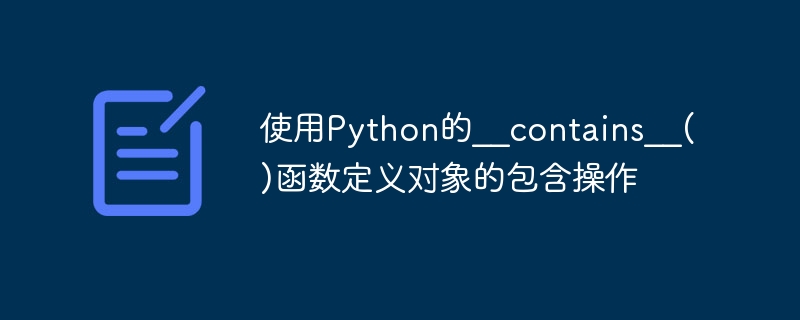

Use Python's __contains__() function to define the containment operation of an object
Python is a concise and powerful programming language that provides many powerful features to handle Various types of data. One of them is to implement the containment operation of objects by defining the __contains__() function. This article will introduce how to use the __contains__() function to define the containment operation of an object, and give some sample code.
__contains__() function is one of Python's built-in functions, used to define the behavior of the inclusion operator "in". When using "in" to check whether an object contains an element, Python will look for the __contains__() function defined in the object and call this function to perform the containment operation. The following is the basic syntax of the __contains__() function:
def __contains__(self, item):
# 包含操作的逻辑代码
passAmong them, self refers to the object itself, and item is the element that needs to be judged whether it is included. We can write logic code in the __contains__() function to determine whether the object contains the specified element. If it does, return True; otherwise, return False.
Next, we use a sample code to demonstrate how to use the __contains__() function to define the containment operation of an object. Suppose there is an object named Person, which contains a list named friends, which is used to store the names of friends. We want to implement the containment operation by determining whether a person is a friend of the object. The sample code is as follows:
class Person:
def __init__(self, name, friends):
self.name = name
self.friends = friends
def __contains__(self, name):
return name in self.friends
p1 = Person("Alice", ["Bob", "Charlie", "David"])
print("Bob" in p1) # 输出True
print("Emily" in p1) # 输出FalseIn the above sample code, we define a class named Person and initialize the object's name and friend list through the __init__() function. Then, we use the "in" operator in the __contains__() function to determine whether the specified name is in the friend list. If it is, return True; otherwise return False.
Next, we create a Person object named p1, whose friend list contains "Bob", "Charlie" and "David". Then, we use the "in" operator to determine whether "Bob" and "Emily" are friends of the p1 object. Since "Bob" is in the friend list, the first judgment output is True; and "Emily" is not in the friend list, so the second judgment output is False.
Using the __contains__() function to define the containment operation of an object can easily implement custom logic. We can implement different judgment conditions in the __contains__() function according to the specific needs of the object, so as to flexibly judge whether the object contains a certain element.
To sum up, this article introduces the use of Python's __contains__() function to define the containment operation of objects. Through the demonstration of the sample code, we can see that using the __contains__() function can easily and flexibly implement object containment judgment. I hope readers can gain a deeper understanding and application of the __contains__() function in Python through the introduction of this article.
The above is the detailed content of Use Python's __contains__() function to define the containment operation of an object. For more information, please follow other related articles on the PHP Chinese website!




